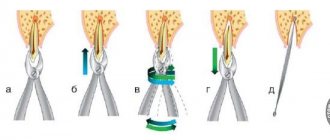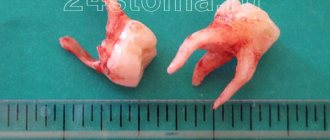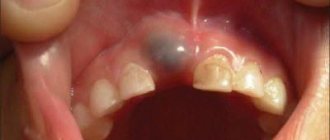Tooth extraction is a very complex process that is carried out under conditions of good sterility and only by a good dental surgeon. But since under certain circumstances the need to get rid of a diseased tooth may arise at home, and there will be no opportunity to seek help from a specialist, in exceptional cases you can carry out such manipulations yourself. It is important to follow the instructions accurately and disinfect all instruments and hands as much as possible.
Attention! Once the procedure is completed, seek medical attention and take an x-ray as soon as possible. This will make it possible to exclude the presence of inflammation and other undesirable consequences after extraction, especially when permanent teeth are pulled out.
How to painlessly extract a tooth?
Content
- When to remove a tooth
- What is recommended to do
- Stages
- What to do after deletion
- Remove wisdom tooth
- Prevention
- Final recommendations
PROMOTION
Inexpensive tooth extraction
from 1000 rub.
Tooth extraction at home is an unsafe event, as there is a high risk of infection. But there are situations in life when it is not possible to seek qualified help. Is it possible to pull out a tooth yourself and avoid complications?
When can you pull out a child’s baby tooth at home?
Changing teeth is a natural and necessary process of development of the maxillofacial apparatus. The peculiarity of the structure of milk jugs is that they have short nerve roots, which makes their loss painless. In most cases, changing milk jugs occurs independently and does not require outside intervention. It is possible to remove a temporary tooth in cases where it is well loosened, but at the same time it interferes with speaking and chewing. In such situations, it is permissible to carry out the manipulation at home without visiting a doctor.
How to understand that you can pull out a child’s baby tooth:
- there is no pain or blood when the milkman staggers;
- healthy pink gums;
- the tooth moves easily back and forth in the hole;
- no stomatitis, gingivitis, tonsillitis;
- The child feels well and is healthy.
When Removal is Required
Doctors recommend removal if:
- The tooth is destroyed to such an extent that filling will not solve the problem;
- With exacerbation of osteomyelitis;
- In the inflammatory process associated with infection;
- With advanced periodontitis;
- If the tooth is positioned incorrectly;
- If the jaw is damaged;
- With severe looseness;
- If a dental unit interferes with prosthetics;
- With severe caries damage.
There are rules to minimize the consequences of self-removal of a problematic tooth.
Should I rush to delete it?
Parents are interested not only in how to correctly pull out a child’s tooth, but also when it can be done. A clear answer to the question is not recommended without medical indications. Because the rudiments have not yet fully formed. They will not erupt for a long time. The absence of at least one element of the dentition leads to the fact that the rest begin to slide, taking up free space, which leads to an incorrect bite. Those that should be in a specific place will not come out before their due date. This means that when the time comes, they simply will have nowhere to grow.
Among the dangerous consequences of this procedure:
- the appearance of painful and unpleasant sensations during teething;
- change in diction, habit of burring;
- incorrect jaw structure;
- problems with digesting food.
Therefore, it is better to refrain from deleting in advance if there is no reason for this.
Preparatory stage
To reduce risks as much as possible, you must:
- Brush your teeth;
- Rinse your mouth with balm, calendula tincture or chlorhexidine.
- Take a painkiller and wait half an hour.
Prepare:
- Antiseptics;
- Spitting container;
- Tampons and sterile gauze pads;
- Mirror.
The use of pliers and similar tools is prohibited.
Sequence of actions if you need to pull out a tooth at home:
- Cover the tooth with sterile gauze, grasp it tightly and slowly loosen it to remove it from the socket;
- Use tampons to remove accumulated blood;
- Act slowly and forcefully so that no root fragments remain in the hole;
- After extracting the tooth, apply a tampon to the wound and bite it firmly;
- After half an hour, carefully remove the tampon so as not to provoke bleeding.
Do not drink or eat for the next 4 hours. Apply cooling compresses for several minutes. In the next few days, eliminate bad habits and do not use physical activity.
When they start to fall out
This phenomenon can be encountered when the child turns 5-6 years old. It occurs due to the fact that the jaws begin to grow. It is completely painless for most children, due to the fact that during the growth of the radical replacement, the roots of baby teeth are reabsorbed. They become mobile and then fall out. This is ideal.
There are cases when improper formation is observed, especially of premolars, and very rarely of incisors and canines. Due to the violation, resorption does not occur on time. Careful removal is required so that they can grow healthy and even in the future.
Lasts up to 10-12 years, depending on the individual characteristics of the body. Interestingly, in girls it begins earlier and proceeds much easier and faster than in boys.
Actions after removal
It is necessary to monitor the patient's condition for several days.
Negative manifestations if:
- The wound bleeds an hour after removal;
- There is clouding of consciousness;
- The person has a fever;
- The pain has become pulsating in nature - an urgent examination by a dentist is necessary, as a jaw injury is possible.
The difference in how to pull out a molar at home or a baby tooth is only in the length of the roots. To minimize negative consequences, it is necessary to work in gloves treated with an antiseptic composition.
How to keep teeth healthy for adults
Changing teeth occurs only once in a lifetime. Permanent teeth require special care, since once they fall out there will be no new ones. To ensure your teeth last as long as possible, doctors at the Center for Israeli Dentistry recommend adhering to the following rules:
- Visit your dentist twice a year for a checkup.
- Get timely treatment for caries and other dental diseases.
- Brush your teeth twice a day.
- Limit the consumption of sweets - the main factor in the growth of pathogenic bacteria in the oral cavity.
And remember that gum and dental diseases are easier to treat in the early stages. Therefore, at the first symptoms, immediately seek help from a doctor.
Wisdom tooth removal
If pulling out a baby tooth at home is not a particular problem, then with a wisdom tooth things are different. This dental unit can be removed only if it can be firmly grasped and loosened. Cutting the gum is prohibited so as not to damage the nerve of the lower jaw. For convenience, you need to place a tampon between your gum and cheek. “Eights” have longer roots, so independent removal is almost impossible. This procedure must be performed in a specialized institution.
When it is prohibited for an adult or child to pull out a tooth at home:
- If the gums are very swollen and there is no way to act carefully;
- With purulent abscess, with gumboil;
- If a person has a fever;
- If the tooth is crumbled;
- With excessive sensitivity.
Why is it dangerous to leave a tooth root in the gum?
- The inflammatory process in it has not stopped, the danger of inflammation of the jaw tissue increases;
- Caries can spread to neighboring teeth;
- ENT diseases may develop.
The root of the damaged tooth must be removed. This is a complex procedure that requires the use of antibacterial drugs and anesthesia. It should be performed by an experienced doctor.
Removing tooth roots on your own is dangerous, as it is difficult to remove them completely. In addition, there is a high risk of infection of the hole.
You can solve this problem yourself only under certain conditions:
- The damaged tooth is very loose;
- It’s impossible to get to the dentist’s office, and the tooth hurts unbearably.
What risks exist:
- Inflammation may develop;
- The root can only be partially removed;
- Possible heavy bleeding.
Do not use the door handle for removal. Safe removal is possible only after systematic loosening.
To do this with minimal risk of tissue damage and infection, you need to follow a number of recommendations.
- Assess the situation - whether you can cope with the task. If the tooth is tightly fixed, is it worth starting extraction? A tooth that is tightly held cannot be removed.
- A loose tooth should be further loosened with the tongue. Perhaps it will fall out on its own.
- Before attempting to extract the root, wash the flour, brush your teeth with toothpaste, and rinse your mouth with a disinfectant (rinse) to ensure maximum disinfection. You can use special solutions. It is important that they contain alcohol.
- Use of painkillers. The painkiller should not cause side effects. For the drug to take effect, you must wait at least half an hour.
Prevention of complications
The difficulty of the procedure is to avoid infection, since if microbes enter, complications will affect the entire oral cavity. To speed up wound healing, you need:
- When talking, try not to touch the hole;
- Monitor the integrity of the blood clot, which performs a protective function;
- For the first 4 hours after removal, do not eat, chew on the healthy side;
- Brush your teeth carefully and thoroughly, avoiding the socket so as not to damage the blood clot;
- Include food with plenty of liquid in the menu;
- Avoid cold and hot dishes;
- After eating, rinse your mouth with clean water or furatsilin solution to neutralize oozing blood;
- Apply warm, damp compresses to stimulate blood circulation.
Swelling may occur immediately after removal. If pain and swelling disappear within a few days, it means healing is proceeding normally.
Loosening
Most people lose their baby teeth around age 6. If a loose tooth has been driving you crazy for weeks and you're afraid to pull it, don't worry! You can get rid of that annoying loose tooth without any problems. With a few simple tricks, your tooth will be under your pillow waiting for the Tooth Fairy before you know it!
The best thing about this type of tooth loosening is that you can do it almost anywhere. Try to loosen the tooth forward - backward, from side to side or by pressing on it towards the middle of the mouth; do whatever you can to your tooth with your tongue, as long as it doesn't cause you pain.
You may experience an itchy sensation near the root of the tooth. This is a sign that the tooth is ready to be extracted. Using your finger, try to rock the tooth even more. Every day, you can gently move a loose tooth with a clean finger. This will help the tooth fall out on its own. But do not use force when moving the tooth.
Important. Be sure to wash your hands well with soap and warm water before using this method. Bite crunchy food. Another way to help your loose tooth fall out is to enjoy normal, healthy foods. Apples and pears work well due to their hard skin and crunchy texture.
If your tooth is very loose, you may find it difficult to bite into these types of foods. However, biting with your remaining teeth and chewing your food can also help you get rid of a loose tooth. If the tooth is slightly loose and you bite into something hard, it may hurt. Gently bite foods with this tooth.
Brush your teeth. When a tooth is really loose, putting a little pressure on it can make it fall out. Sometimes even brushing your teeth will help the tooth fall out (or at least become more loose). Brush your teeth as usual, but quickly (at least twice a day), paying special attention to any loose teeth.
Grab the tooth with gauze. You can pull on a tooth to further loosen it, even if it's not ready to fall out on its own or if you don't want to pull it. Using sterile gauze and your fingers, grasp the tooth and gently pull or loosen it.
If you don't want to pull the tooth, you can use this same method, rotating the tooth a little as you pull. Gauze will help remove blood if there is any. You can also apply a little oral numbing agent to the tooth and gum before pulling if you're worried it will hurt.
Try to wait. If your tooth is not going to fall out, it may not be time for it to fall out yet, be patient. If a loose tooth does not cause you discomfort, pain or interfere with your other teeth, you can safely wait.
Typically, baby teeth fall out in the order in which they appeared, around the age of 6–7 years. However, teeth may fall out in different orders and at different times. Your dentist will examine your teeth and answer any questions you may have about tooth loss. You should not forcefully pull out a tooth that is not yet ready to fall out.
There is usually nothing good about trying to pull out a baby tooth that has just started to loosen and is not yet ready to fall out. This procedure can be painful and usually results in heavy bleeding as well as possible infection. If a tooth is pulled before the permanent tooth is ready to grow out from under it, you may face problems in the future, such as uneven teeth or insufficient space for new teeth.
Give up the idea of extracting a tooth using extreme methods. For example, you should not tie one end of a thread to a tooth, the other to a door handle, and then suddenly open the door to pull out the tooth. This can break the tooth and cause serious injury.
If you accidentally knock out one of your teeth before it's ready to fall out, contact your dentist to make sure it doesn't cause a problem. If all else fails, see your dentist. If your baby tooth hurts and won't fall out no matter what you do, don't be afraid to seek help.
Make an appointment with your dentist, he or she will be able to tell you what is preventing the tooth from falling out naturally and can even painlessly pull the tooth out.
Preparing the child
The natural process of changing your bite is usually easy and painless. However, there are times when parental or dental intervention is required. Children are afraid of being hurt, of any outside interference. Therefore, when hesitation is noticed, it is necessary to conduct moral preparation of the child.
It is enough to explain that this is normal. A 5-year-old child will not be able to perceive information correctly, so it is better to use simple figures of speech and a playful form. Mythological children's thinking responds well to all kinds of fairy tales. You can read to your child a special collection of stories dedicated to this phenomenon. Prepare gifts from a fairy-tale character for your patience.
Is it painful to remove molars?
Today, only older people remember the terrible pain during the removal of molars. Nowadays, the quality of painkillers is so high that the patient does not feel pain at all, even with difficult removal. At the same time, after the anesthesia wears off, pain, of course, occurs, but it is quite tolerable and depends on how much the gum under the tooth was disturbed.
If the pain is still severe, then the dentist recommends taking a painkiller tablet. The same analgin successfully dulls pain for a long time.
In rare cases, the patient may experience throbbing and increasing pain. This annoying phenomenon occurs due to inflammation of the socket. If measures are not taken quickly, the tissue begins to fester in the hole. This process can be suppressed with drug treatment, but sometimes you have to open the gum and clean the hole from pus.
Where can you go at night if you have a toothache?
Many of us live in big cities, where medicine is at the highest level. But this happens during the daytime and on weekdays, and at night, on holidays and weekends, we feel insecure and sometimes don’t know where to turn for help. For example, with an acute toothache that takes you by surprise and gives you no rest. What to do then? So the journalists from the editorial office of the UltraSmile.ru portal asked themselves this question. Let's look for answers to it together!
It’s good if you always have the city’s emergency and emergency phone numbers at hand, so that in the event of an unforeseen situation you can call and ask all your questions without panic. If there are no important numbers, then call the 24-hour helpline of the city or locality where you are currently located.
24-hour pharmacy
Do you agree that when a tooth hurts, the first thing we think about is not where to run, but how to relieve the pain? And accordingly, we take the right pill. Especially when trouble occurs late in the evening, at night or after hours. I don’t want to go or run anywhere during this period of time. But there are also such situations - you have a toothache, but at that very moment there was no analgesic in your home medicine cabinet: the medicine has run out, the expiration date of the medicine has expired. In this case, it would be a good idea to find out if there is a 24-hour pharmacy in the city and buy a medicine that will relieve unpleasant symptoms for a certain period of time and help you get a restful sleep. This could be Nurofen, Nise, Ketorol, Ketanov, Baralgin.
In the morning, of course, you need to make an appointment with a professional dentist or go without an appointment to any public dental clinic that accepts under the compulsory medical insurance policy.
A 24-hour pharmacy will help if the pain occurs late in the evening or at night
If you are in a village, in a country house, and there are no large settlements nearby, then try using simple folk remedies: a clove of garlic on the wrist, rinsing with soda-salt solution, chamomile, massage.
When none of the listed measures bring relief, then it’s time to think about more serious actions and contact a medical facility.
Urban emergency dental care centers
As a rule, these are ordinary clinics, which are supported by the state and the city, or an emergency room at a regional dentistry, where round-the-clock duty is organized. But even in the largest cities, such as Moscow, there are no more than one or two of them for the entire population. These clinics have an on-call room where you can go to resolve an emergency.
To be accepted at night or on holidays, it is enough to provide an identification document and a compulsory health insurance policy. It does not matter whether you belong to this organization at your place of residence or your official registration. It also does not matter which clinic you are assigned to.
This is interesting: Treatment and removal of teeth with laser: pros and cons, how laser therapy is carried out
For example, in Moscow there are two night departments: for children under eighteen years of age, you can count on help in emergency cases at Dentistry No. 28. The center’s specialists provide their services free of charge from 18:00 to 8:30 on weekdays. And also at any time of the day or night on holidays and weekends. For adults - emergency admission of all citizens is carried out by the State Budgetary Healthcare Institution 1 "Maxillofacial Hospital for War Veterans", opening hours from eight in the evening to eight in the morning.
Clinics that are supported by the state
For what types of pain and dental pathologies can specialists provide assistance at night:
- relieve acute pain syndrome in any type of dental problem,
- provide first aid for pulpitis, caries, periodontitis, alveolitis and periostitis, the presence of cysts and granulomas,
- stop alveolar bleeding,
- carry out emergency surgical intervention if the patient presents with jaw injuries, fractures and dislocations of teeth,
- remove a tooth: but not in the case of “eights”. Wisdom teeth removal is often considered difficult and requires a thorough diagnosis of the situation. Therefore, depending on the clinical case and the equipment of the clinic, the doctor may recommend that you come for an appointment during the daytime and make an appointment (although in case of an emergency, city clinics accept patients without an appointment).
Services here will be provided free of charge. The only thing you may need to pay for is an imported anesthetic injection before treatment.
I am shocked by our city clinic in Chita. We arrived at night, there were four people in line for one doctor, we sat there for two hours. The pain was unbearable, the pills did not help. At the same time, the tooth was intact, there wasn’t even a filling on it, and it was unclear why it hurt. The doctor was rude and said, why are you coming here! You'd think we have nothing else to do at night! Without even looking properly, without x-rays and everything else, she offered to pull the tooth and pay 300 rubles for anesthesia!!! But shouldn’t modern dentists do everything to save the patient’s teeth and how can they be removed without even conducting a normal diagnosis? This is our free medicine and emergency care. The question arises: why be on duty at night if there is only one answer to all situations: we will delete them!
Private dentistry
Acute toothache caught you by surprise at night? People who do not want to spoil their nerves immediately understand where to go: private dental offices or clinics that work around the clock. Here, the service for dental treatment and pain relief, in most cases, will have to be paid according to the current price list. But help will be provided in a timely manner, without unnecessary hassle or questions, and you will feel comfortable.
Some private dentistry may provide free services under the compulsory medical insurance policy, but most often in such cases they ask to provide one more document: SNILS.
You can contact 24-hour private dental clinics
Also, most private dental centers have uninterrupted 24-hour and toll-free communication lines for support and consultation of patients. Therefore, you can always call such a service and get clear recommendations on how to proceed.
Regular trauma center
If there are no 24-hour dentists in your city, then there are definitely trauma centers. Yes, the doctors on duty are not dentists and will not be able to cure your tooth, but they will be able to select medications that will relieve acute pain and help you last until the morning.
Help can also be provided at a trauma center.
If an institution operating in accordance with health care standards and providing services under the compulsory medical insurance policy refuses to accept you in an emergency, then you can directly contact the hotline of the City Health Service or the Ministry of Health of Russia, multi-channel telephone2.
Ambulance or urgent care
This option is suitable only for those people who have suffered dental problems and pain as a result of maxillofacial injuries, accidents and falls. In all other cases, the ambulance dispatcher will refuse hospitalization and, as practice shows, will not respond to the call. But the specialist will be able to tell you which institutions in the city you can contact with your problem or give advice on how to relieve toothache before your next visit to the dental clinic.
Sources
- https://melioradent.ru/stati/vyrvat-zub-v-domashnih-usloviyah/
- https://zubast.ru/zuby/kak-vyrvat-korennoj-v-domashnih-usloviyah.html
- https://stomatolab.com/lechenie/udalenie/zuba-v-domashnix-usloviyax.html
- https://MedBoli.ru/zabolevaniya/kak-vyrvat-zub-v-domashnih-usloviyah-bez-boli
- https://ultrasmile.ru/kuda-obratitsja-nochju-esli-bolit-zub/
Can the root “come out” on its own?
Some patients, due to fear of pain and other discomfort, wrongly believe that if no action is taken, the base will fall out on its own over time. They walk around for many years with rotting bone remains in their mouths, creating a favorable environment for the development and spread of pathogenic microorganisms. An unpleasant odor appears in the mouth. Sometimes the root can actually come out without outside intervention, but this happens extremely rarely.
How events usually develop if you don’t visit the dentist on time:
- Hard deposits and stones form on the surface. The mucous membranes surrounding the base are irritated.
- The gums become overgrown and a severe inflammatory process develops. Subsequently, soft tissue dissection will be required.
If there are root fragments left in the hole
If the wound edges were tightened with catgut, the patient’s treatment can be considered complete. If a non-absorbable material was used, the patient will have to return to the dentist to have the sutures removed after a week. During this time, it is necessary to monitor the condition of the gums, your own sensations and notify the doctor if:
- the operated areas constantly hurt;
- throbbing pain is felt.
This means that small fragments of tooth tissue, which may have gone unnoticed during extraction, rot in the hole. The doctor must prescribe a repeat X-ray for the patient, check the quality of the operation and find out the cause of the ailment. Inaction is fraught with the development of alveolitis (inflammation of the socket), osteomyelitis, phlegmon and other serious diseases.
How painful is the procedure?
First of all, most patients are interested in whether it hurts to pull out the root of a tooth and pull out fragments from the alveoli. Modern dentistry uses high-quality anesthesia, under the influence of which the patient feels comfortable and calm during extraction. Drugs are selected for any pain threshold on an individual basis. As a rule, the effect of medicinal compositions persists not only during the period of surgical procedures, but also for several hours after them. Sometimes general anesthesia is required.
The choice of pain relief method depends mainly on the following factors:
- patient's age;
- health conditions;
- complexity of the planned operation.
How long the intervention will last depends on the clinical picture, the condition of the root part, the tooth as a whole and the characteristics of the body. The localization of the unit also plays a vital role. An experienced doctor can handle it in half an hour. However, in difficult cases when it is necessary to get rid of the “eight”, the process can take up to 1.5 hours or more.
Preventive actions
The main prevention of possible complications after tooth root removal is the patient’s compliance with all recommendations given by the dentist. These include:
- after the operation, you need to press the gauze swab tightly against the hole for 15-20 minutes and then remove it;
- During the day, it is necessary to treat the fresh wound very carefully so as not to disturb the formed clot. For example, you will have to give up mechanical teeth cleaning;
- for five hours after surgical removal of the tooth root, you should stop drinking hot foods and eating;
To avoid inflammation, you should contact your dentist again at the slightest suspicion.
Comments
My tooth has broken off at the very root, only a stump sticks out. Now I'm afraid to remove it because it will hurt.
Alexander (06.29.2020 at 12:35) Reply to comment
- Dear Alexander, don’t be afraid of anything, in dentistry the procedure will be completely painless. Yes, if only a small fragment of the tooth remains, then removal will be difficult, possibly involving an incision in the gums, but after that you will need stitches. The main thing that will help avoid complications later is to follow all the doctor’s recommendations. And under no circumstances try to remove such a tooth at home, since the likelihood of its complete extraction is very small, but the risk of leaving splinters and debris inside, which will cause an acute infectious and inflammatory process, is very high.
Editorial staff of the portal UltraSmile.ru (07/03/2020 at 09:14) Reply to comment
Last year I had two teeth removed for free at the municipal dental clinic. Easy, fast and painless. A week ago I turned to a nearby dental clinic with the same request. Paid two and a half thousand rubles. After the anesthesia injection, the doctor pulled out my tooth with terrible pain. I literally passed out from the pain. She explained that this happened because I took an analgin tablet at night to calm the pain. Is she right?
Sergey Petrovich (07/23/2020 at 08:59) Reply to comment
Is it necessary to pull out a loose baby tooth in children? I know completely different opinions and someone says that it is absolutely necessary to “help” the tooth fall out. Allegedly, if this is not done, the new tooth may go sideways.
Vasily Shchigolev (07/23/2020 at 09:02) Reply to comment
Tell me, is it necessary to remove a child’s baby teeth if they are already destroyed and cannot be treated? After all, this is a huge stress for a child, and I don’t dare to go under anesthesia. Or should I wait until my baby teeth change to permanent ones?
Ekaterina (07/23/2020 at 09:03) Reply to comment
It is not always possible to see a doctor. My grandfather lived in an abandoned village very far from the city. I pulled out my teeth myself with pliers. He will soak them in a glass of vodka for disinfection, vomit them, and then drink this glass. Is it dangerous to do this?
5master5 (07/23/2020 at 09:32) Reply to comment
Good afternoon. It turned out that I don’t like dentists, so I decided to pull out my tooth at home. I did this under anesthesia. I thought that everything went well, but I realized that I only pulled out a piece of the tooth, and the remaining piece ached wildly and prevented me from chewing food. What to do?
Vera (07/23/2020 at 10:20 am) Reply to comment
But if you do remove an impacted “eight” tooth in the clinic, what is the best anesthesia to choose so that it doesn’t take so long to recover, so that it’s not scary or painful? I’m very afraid and my tooth has already started to hurt.
Maria (07/23/2020 at 10:53 am) Reply to comment
Good afternoon I will see a doctor by appointment only in 3 weeks. But the tooth hurts, I have no strength, painkillers hardly help. Is it possible to somehow remove it at home or take some action to reduce this pain? Thank you
Anna (07/23/2020 at 10:59 am) Reply to comment
My upper tooth broke and a large piece fell off. Half of the tooth remains. How does the removal procedure take place in this case?
Varvara (07/23/2020 at 11:09 am) Reply to comment
My upper tooth is broken. Half of the tooth remains. At the same time, the place where the tooth broke off hurts greatly. How does the removal procedure occur in this case? How does pain relief occur?
Varvara (07/23/2020 at 11:16 am) Reply to comment
At the site of the removed tooth, a fragment remained. I feel it very well. The neighbor said that she had a similar situation and then, as the wound began to heal, the fragment came out on its own. Please advise what is the best thing to do - go to the dentist or can I try to get it out myself? Maybe he really will come out on his own over time?
Larisa (07/23/2020 at 11:51 am) Reply to comment
At the site of the removed tooth, a fragment remained. I feel it very well. The neighbor said that she had a similar situation and then, as the wound began to heal, the fragment came out on its own. Please advise what is the best thing to do - go to the dentist or can I try to get it out myself? Maybe he really will come out on his own over time?
Larisa (07/23/2020 at 11:54 am) Reply to comment











